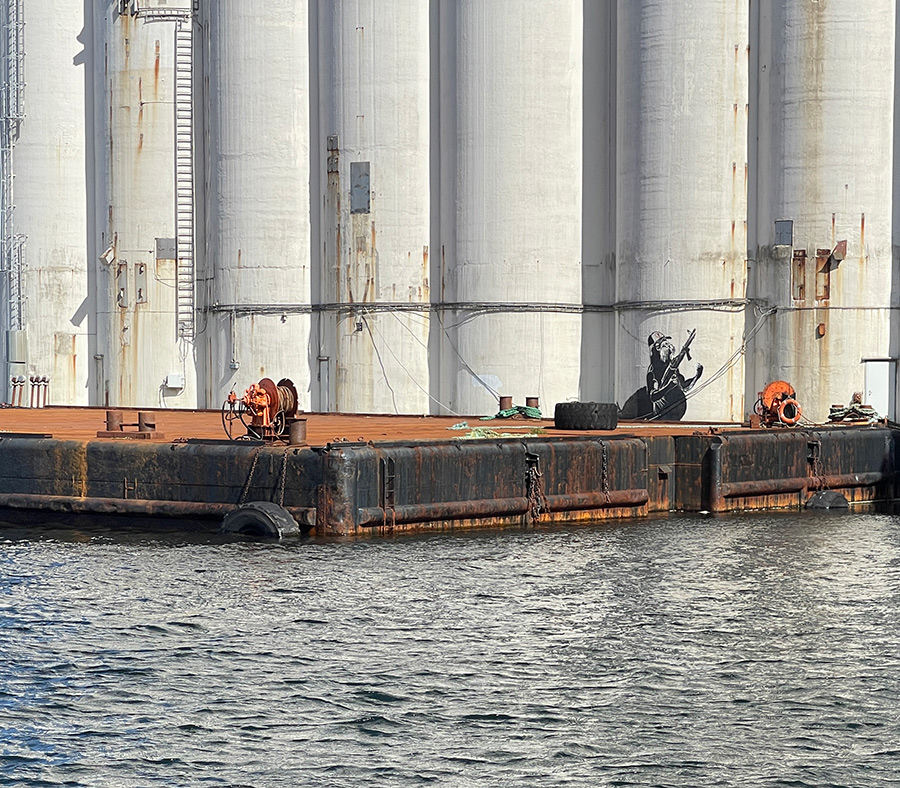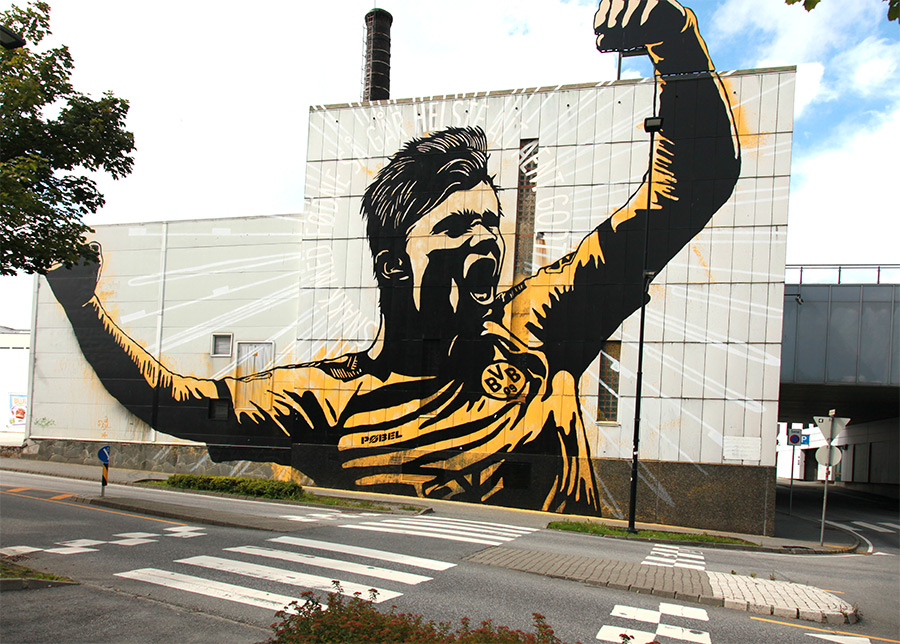
A Personal Stencil Evolution Continues
Pøbel embarked on his street art journey by fashioning modest stencils in his studio, yet now he conquers towering facades with bold prominence. A cornerstone of this year’s Nice Surprise Festival in Stavanger, Norway, Pøbel stands as an artistic powerhouse, well-versed in history and the global network of his peers. With summer’s curtain not yet drawn, he teasingly hints at the possibility of one more Nice Surprise, a cunning twist up his sleeve.

A quarter-century after he embarked on the quest to master the art of stencil-making, sparked by the electric resonance of his favorite band Rage Against the Machine and their fervent political lyrics, Pøbel has transmuted stencils into instruments of advocating for social justice and an array of politically/socially charged perspectives, painted boldly on the street canvas, sometimes within the lines of legality, and occasionally elsewhere.

Delving briefly into this captivating stencil narrative, you unearth the DNA of Pøbel and an entire generation of street artists intertwined within. It all began with a Che Guevara stencil that fueled Pøbel’s desire to craft his own. This iconic image was heavily wielded by Rage et al. during the 1990s – its origins tracing back to the fervent student uprisings in Paris in 1968, a time of civil upheaval driven by a collection of factors encompassing political, societal, and economic dimensions. Thus, the link between activism, outlaw street art, and the stenciled story is as vivid as his colors.

The original photograph of Che, immortalized by Alberto Korda as ‘Guerillero Heroico,’ was transformed into a stencil by Jim Fitzpatrick, yielding 1000 posters disseminated to student movements and marches advocating against the establishment and imperialism during the late 1960s. Yet, an unsavory tale emerges as well – Gerard Malanga, anointed Warhol Superstar, poet, and photographer, propagated counterfeit Warhol canvases bearing multiple renditions of this very image, consorting with a European gallery to peddle them without Warhol’s knowledge or consent. “Warhol was alerted and claimed the piece – and its royalties” (Warholstars | WikiArt). Regrettably, our story shows that a similar shadowy side has weaved through the contemporary art story over the past century. As an artist, Pøbel certainly has tales to share.


Pøbel wields his artistic prowess like a clandestine truth-seeking missile launcher, propelling thought-provoking explosives and orchestrating silent symphonies in his unfiltered dialogue with the social and political arena. Not a seeker of confrontations, he jestingly beckons you to ponder because he believes that issues like inequality, consumerism, corporate dominion, and our fragile environment deserve a closer look. It’s not that he shies away from commercial ventures; he prefers to provoke pondering with his initiatives.


It could be the fusion of bold contours and sometimes vibrant hues meld with punchlines that pack an unexpected wallop? A sprinkle of humor, an occasional conceptual sculpture, and whimsy don’t hurt either – remember that time he merrily buried a bus in the sand? The very bus that vexed the populace in Vardø, a quaint town where he had just wrapped up another curated street art extravaganza named Komafest. Much like ‘Nice Surprise,’ it showcased luminaries whose art practice is respected and whose reputations have aged well – the likes of Conor Harrington from Ireland, Vhils from Lisbon, and Stephen Powers from the concrete jungle, New York, for example. Amidst final-party revelry at a bar, a tipsy conversation spiraled into a sandy escapade come dawn, birthing a chain of events that culminated in a sudden public art installation, even coaxing the mayor to partake in the unauthorized spectacle.

The vertical sculpture became a time capsule, a repository for ephemera and memories generously contributed by the community. “At one point, when we were finished, I was at the bar and this mature woman was coming over and, she began reaching out to my hand and I shook her hand and she was like, ‘thank you very much, thank you for everything.’ And I’m like, ‘no problem’ and I was going to take away my hand,” he recollects. “Then she grabbed really firm with purpose, and she said something like, ‘I don’t think you understand, thank you’. And then there was this tear coming down.” Moments like these are etched in his memory. Spontaneous as it was, the bus idea resonated deeply with the community in a way he never could have foreseen.

Artist, curator, activist, mischievous spirit, and consensus-seeker, Pøbel wears many hats, and his work has kindled both admiration and critique in his homeland, Norway. Just as art takes myriad forms, eliciting a spectrum of reactions, here are some Pøbel pieces we encountered and a couple that perhaps eluded us during our sojourn in this vibrant enclave, where brisk gusts of Nordic air meet astute minds.




 BROOKLYN STREET ART LOVES YOU MORE EVERY DAY
BROOKLYN STREET ART LOVES YOU MORE EVERY DAY










